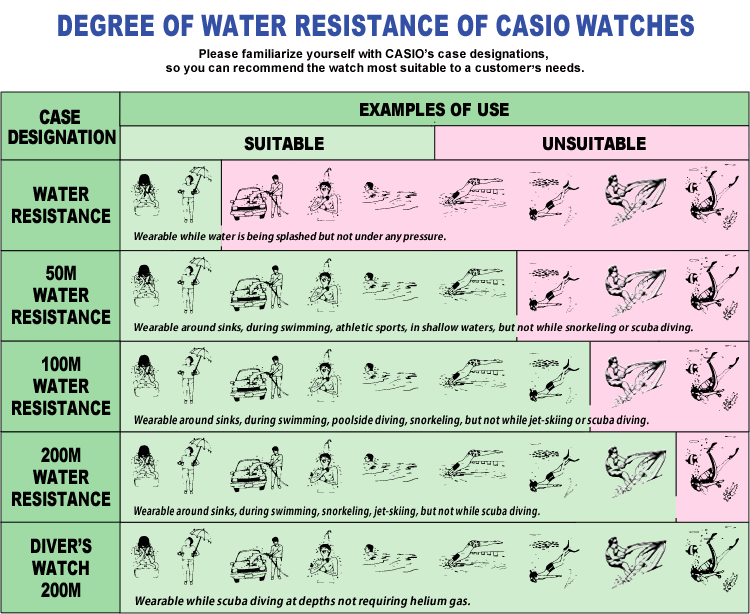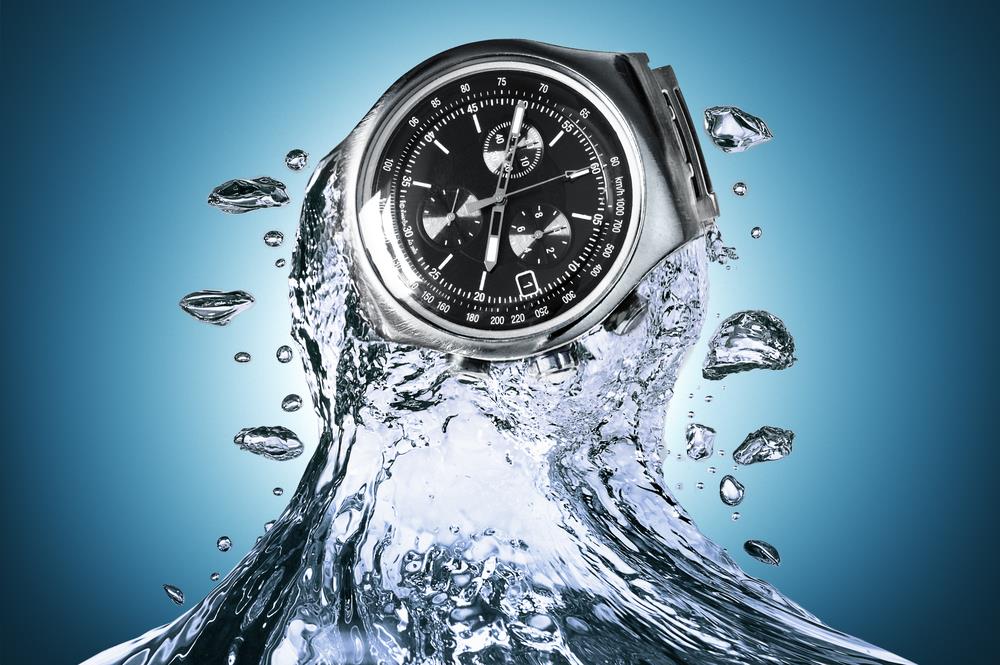Water resistance rating is an important indicator that states the capacity a wristwatch can handle when underwater. It is one of the most significant features presented and developed as people nowadays explore and travel a lot and are thus highly likely to go underwater at some point in their lives.
This is then developed and researched to provide the best quality possible to allow function and comfort while swimming or even diving.
With all the different and new features of watches, the water resistance rating may be easily overlooked and misunderstood. What seems like a simple engraving on the watch saying ‘50M water resistance’ actually holds a lot of information and precautions when wearing the timepiece.
Unfortunately, people seldom understand what it really means and what their standards are meant to serve. A careful analysis and interpretation should be done and will be explained in this article.
Depth by meters

Before getting into the different standards, let’s look at a common question by watch owners. What does the ‘meters’ sign actually denote? And what activities are affected per meter listed? As explained by Casio, and as a rule of thumb, they explained the allowances and restrictions each depth states:
- Water resistance: Wearable when water is splashed on the watch where no pressure is placed.
- 50m water resistance: Wearable around sinks and at activities such as normal swimming, athletic sports, and at shallow waters only. Snorkeling and underwater diving is not allowed.
- 100m water resistance: Wearable around sinks and activities such as swimming, sports, poolside diving, and snorkeling. Jet skiing and scuba diving are still not allowed.
- 200m water resistance: Wearable around sinks, swimming, sports, snorkeling, jet skiing, but not scuba diving.
- Diver’s watch: Wearable at all above-mentioned activities including scuba diving except at instances and depths where helium gas is needed.
Bars and ATM
There are certain terminologies you have to be familiar with first. Bars, and ATM are common words you would see or read about when it comes to watch standards and tests conducted on them.
They are usually used to see the durability of the watch relating to resistance against different types of pressure taken by watches.
Bars refer to the pressure exerted on an object under water. It may be noted, though, that when converted, 1 bar is equal to 10 meters or 32 feet. ATM is a short term for atmosphere, and refers to air pressure above water. To start with, 1 ATM is the normal pressure at sea level. 10 ATM would simply mean that the watch can withstand the pressure of ten times the amount at sea level pressure without succumbing to the water pressure.
If a watch is rated at 50 meters, you can go down to that distance theoretically. However, to do so, would be put the object under too much pressure. If your watch is rated as such, be sure to give a bit of an allowance at the depth it can go under water due to the simple fact that the moving water can also create additional pressure therefore at a similar depth pressure may differ.
For conversions between bars, ATM, and distance:
1 bar = 1 ATM = 10 meters = 32 feet,
so we convert 10 ATM = 10 bars = 100 meters underwater,
or 10 ATM = 10 bars = 320 feet underwater
To follow;
20 ATM = 200 meters = 640 feet = 20 bars
30 ATM = 300 meters = 960 feet = 30 bars
50 ATM = 500 meters = 1600 feet = 50 bars
100 ATM = 1000 meters = 3200 feet = 100 bars
ISO Ratings
You might have read about ISO 2281:1990 and ISO 6425:1996. These two are special standards for watches regarding their functionality underwater. They are different on the level of procedure and pressure endured.
The first is a standard used for wristwatches worn at a daily basis. The second one is a standard utilized by diving watches where depth and pressure play an important role in its water resistance rating.
When watches pass the test for ISO 2281, they can then be officially marked as “water-resistant” watches, with the rating indicated along it. For diver’s watches, they have to pass ISO 6425 tests in order to determine their strength under pressure.
“WR”, a common term in watches, simply refers to its water resistance rating. It denotes the durability of a watch to withstand the indicated pressure.
ISO 2281:1990
This international standard specifies the different tests required in order to allow a watch to bear the words ‘water-resistant’.
This standard is meant for wristwatches held on a daily basis and are used in different occasions such as exercising, light swimming, and other related normal activities.
However, whether or not there is an indication on the timepiece of overpressure, watches bearing ‘water-resistant’ engravings are not intended for submarine diving. That means you can wear the watch when going scuba diving, but do it at your own risk!
Testing is voluntary and only a sample of the type of watch is required for the testing. Listed below are the requirements and tests required for watches to be allowed to bear the feature ‘water-resistant’:
- Resistance when watch is under 10cm of water for 1 hour.
- Resistance for operations when watch is under 10cm of water with 5N force on buttons for 5 minutes.
- Resistance to condensation when watch is placed on a heated area of about 40 Celsius – 45 Celsius, afterwards an 18 Celsius – 25 Celsius droplet of water is dropped and wiped after 1 minute, whereas the glass should not show any signs of condensation afterwards.
- Resistance to temperature when watch is placed on a heated cushion at 40 Celsius, 20 Celsius, and 40 Celsius respectively for 5 minutes each, with an interval of 1 minute or less per transition, whereas the glass should not show any signs of condensation afterwards.
- Resistance to water overpressure when watch is submerged in water, wherein within 1 minute is subject to indicated pressure (or 2 bars when there is no indication) and maintained for 10 minutes; afterwards pressure is gradually decreased in 1 minute and check if there is no water intrusion or condensation afterwards.
- Resistance to air pressure when watch is subject to an air pressure of 2 bars whereas watch will be observed if there is air flow in the case.
- Other tests such as negative pressure, strap attachment, corrosion test is not required for this.
ISO 6425:1996
This is a stricter standard compared to the previous one as it is applied to diving watches where depths of at least 100m and above are traversed. Watches under this category are tested up to 125% their rated pressure.
As this is an important standard, every single watch is to be tested and not just a sample. It is still a voluntary testing where costs are shouldered by the manufacturers. Below are the tests conducted for the diving watches:
- Reliability under water when watch is submerged at about 30cm for 50 hours within 18 Celsius – 25 Celsius and afterwards checked if all features and functions still work
- Reliability against condensation when watch is placed on a heated cushion at 40 Celsius, 20 Celsius, and 40 Celsius respectively for 5 minutes each, with an interval of 1 minute or less per transition, whereas the glass should not show any signs of condensation afterwards.
- Resistance against external forces when watch is subjected to overpressure underwater at 125% rated resistance for 10 minutes and 5N of force will be perpendicularly applied at crown and buttons.
- Water-tightness test whereas watch will be underwater at 125% rated pressure under 1 minute and maintained for 2 hours, subsequently reduced to 0.3 bar within 1 minute and maintained as well for 1 hour, after which the watch will be tested against water intrusion and condensation.
- Resistance to thermal shock when watch is submerged at about 30cm at 40 Celsius, 5 Celsius, and 40 Celsius respectively for 10 minutes each, with an interval of 1 minute or less per transition, whereas the glass should not show any signs of condensation or water intrusion afterwards.
Please take note that the actual conducted tests by ISO is more stringent and complicated. The tests listed above are just a part of the entire process but these constitute most of the important standard testing procedures to properly and more accurately assess the true quality and durability of each watch that they test.
It can be noted that there are times that watches which pass the ISO 2281 standard are capable of being used for scuba diving, but divers should do that at their own risk.
A lot of research and development has been invested to ensure that these watches withstand a certain depth at different uses.
There are a lot of dizzying terms but are really useful regulations concerning the standards of water resistance that must be understood. Ample research should be conducted in order to assess which type of watch fits best according to what you do and what you need.
It may be confusing at first, but knowing what you really want and need makes sure that what you get is the perfect fit for you.

Leave a Reply